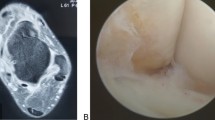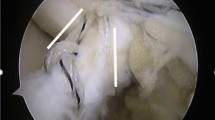Abstract
Purpose
The aim of the study was to compare the intermediate-term clinical outcomes between lateral ligaments augmentation using suture-tape and modified Broström repair in a selected cohort of patients. The hypothesis of the presented study is that suture-tape augmentation technique has comparable clinical and radiological outcomes with arthroscopic Broström repair technique.
Methods
Sixty-one consecutive patients with chronic ankle instability were operated between 2012 and 2016 randomized to 2 groups. First group was composed of 31 patients whom were operated using an arthroscopic Broström repair technique (ABR) and second group was composed of 30 Patients whom were operated using arthroscopic lateral ligaments augmentation using suture-tape internal bracing (AST). At the end of total follow-up time, all patients were evaluated clinically using the Foot and Ankle Outcome Score (FAOS) and Foot and Ankle Ability Measure (FAAM). Radiological evaluation was performed using anterior drawer and varus stress radiographs with standard Telos device in 150 N. Talar tilt angles and anterior talar translation were measured both preoperatively, 1 year postoperatively and at the final follow-up.
Results
Preoperative total FAOS scores for ABR and AST groups were 66.2 ± 12 and 67.1 ± 11, respectively. Postoperative Total FAOS scores for ABR and AST groups were 90.6 ± 5.2 and 91.5 ± 7.7, respectively. There was no statistical difference in between 2 groups both pre- and postoperatively (n.s). According to FAAM, sports activity scores of ABR and AST groups were 84.9 ± 14 and 90.4 ± 12 at the final follow-up, which showed that AST group was significantly superior (p = 0.02). There were no significant differences in preoperative and postoperative stress radiographs between the two groups. Mean operation time for AST and ABR groups were 35.2 min and 48.6 min, respectively, which shows statistically significantly difference (p < 0.05). There was no significant difference in recurrence rate of instability between to operation techniques (n.s).
Conclusions
Arthroscopic lateral ligament augmentation using suture tape shows comparable clinical outcomes to arthroscopic Broström repair in the treatment of chronic ankle instability at intermediate-term follow-up time. Arthroscopic lateral ligament augmentation using suture tape has a significant superiority in the terms of less operation time and no need for cast or brace immediate after surgery which allows early rehabilitation. It also has a significant superiority in the terms of FAAM scores at sports activity. However, there was no difference during daily life.
Level of evidence
II.


Similar content being viewed by others
References
Cho B, Park K, Kim S, Lee H, Choi S (2015) Minimal invasive suture-tape augmentation for chronic ankle instability. Foot Ankle Int 36(11):1330–1338
Cho B, Park K, Park J, SooHoo N (2017) Outcomes of the modified Broström procedure augmented with suture-tape for ankle instability in patients. Foot Ankle Int 38(4):405–411
Cho B, Park J, Choi S, SooHoo N (2017) A Randomized comparison between lateral ligament augmentation using suture-tape and modified Broström repair in young female patients with chronic ankle instability. Foot Ankle Surg. https://doi.org/10.1016/j.fas.2017.10.017
Cottom JM, Rigby RB (2013) The all inside arthroscopic Brostrom procedure: a prospective study of 40 consecutive patients. J Foot Ankle Surg 52:568–574
Guillo S, Cordier G, Sonnery-Cottet B, Bauer T (2014) Anatomical reconstruction of the anterior talofibular and calcaneofibular ligaments with an all-arthroscopic surgical technique. Orthop Traumatol Surg Res 100:413–417
Martin RL, Irrgang JJ, Burdett RG, Conti SF, Van Swearingen JM (2005) Evidence of validity for the foot and ankle ability measure (FAAM). Foot Ankle Int 26:968–983
Matsui K, Burgesson B, Takao M, Stone J, Guillo S, Glazebrook M et al (2016) Minimally invasive surgical treatment for chronic ankle instability: a systematic review. Knee Surg Sports Traumatol Arthrosc 24:1040–1048
Prissel MA, Roukis TS (2014) All-inside, anatomical lateral ankle stabilization for revision and complex primary lateral ankle stabilization: a technique guide. Foot Ankle Spec 7:484–491
Roos EM, Brandsson S, Karlsson J (2001) Validation of the foot and ankle outcome score for ankle ligament reconstruction. Foot Ankle Int 22:788–794
Schuh R, Benca E, Willegger M, Hirtler L, Zandieh S, Holinka J, Windhager R (2016) Comparison of Broström technique, suture anchor repair and tape augmentation for reconstruction of the anterior talofibular ligament. Knee Surg Sports Traumatol Artrosc 24:1101–1107
Vega J, Montesinos E, Malagelada F, Baudell A, Guelfi M, Dalmau-Pastor M (2018) Arthroscopic all-inside anterior talo-fibular ligament repair with suture augmentation gives excellent results in case of poor ligament tissue remnant quality. Knee Surg Sports Traumatol Artrosc. https://doi.org/10.1007/s00167-018-5117-x
Viens NA, Wijdicks CA, Campbell KJ, LaPrade RF, Clanton TO (2014) Anterior talofibular ligament ruptures, part 1: biomechanical comparison of augmented Brostrom repair techniques with the intact anterior talofibular ligament. Am J Sports Med 42:405–411
Willegger M, Benca E, Hirtler L, Hradecky K, Holinka J, Windhager R et al (2016) Biomechanical stability of tape augmentation for anterior talofibular ligament (ATFL) repair compared to the native ATFL. Knee Surg Sports Traumatol Arthrosc 24:1015–1021
Yeo ED, Lee KT, Sung IH, Lee SG, Lee YK (2016) Comparison of all-inside arthroscopic and open techniques for the modified Broström procedure for ankle instability. Foot Ankle Int 37:1037–1045
Youn H, Kim YS, Lee J, Choi WJ, Lee JW (2012) Percutaneous lateral ligament reconstruction with allograft for chronic lateral ankle instability. Foot Ankle Int 33:99–104
Xu X, Hu M, Liu J, Zhu Y, Wang B (2014) Minimally invasive reconstruction of the lateral ankle ligaments using semitendinosus autograft or tendon allograft. Foot Ankle Int 35:1015–1021
Funding
No external funding is used.
Author information
Authors and Affiliations
Corresponding author
Ethics declarations
Conflict of interest
The authors declare that they have no conflict of interest.
Ethical approval
Health Sciences institutional ethical board approval was taken from Acibadem University Ethical Board (Acb.et: 2012.128).
Additional information
Publisher's Note
Springer Nature remains neutral with regard to jurisdictional claims in published maps and institutional affiliations.
Rights and permissions
About this article
Cite this article
Ulku, T.K., Kocaoglu, B., Tok, O. et al. Arthroscopic suture-tape internal bracing is safe as arthroscopic modified Broström repair in the treatment of chronic ankle instability. Knee Surg Sports Traumatol Arthrosc 28, 227–232 (2020). https://doi.org/10.1007/s00167-019-05552-w
Received:
Accepted:
Published:
Issue Date:
DOI: https://doi.org/10.1007/s00167-019-05552-w




